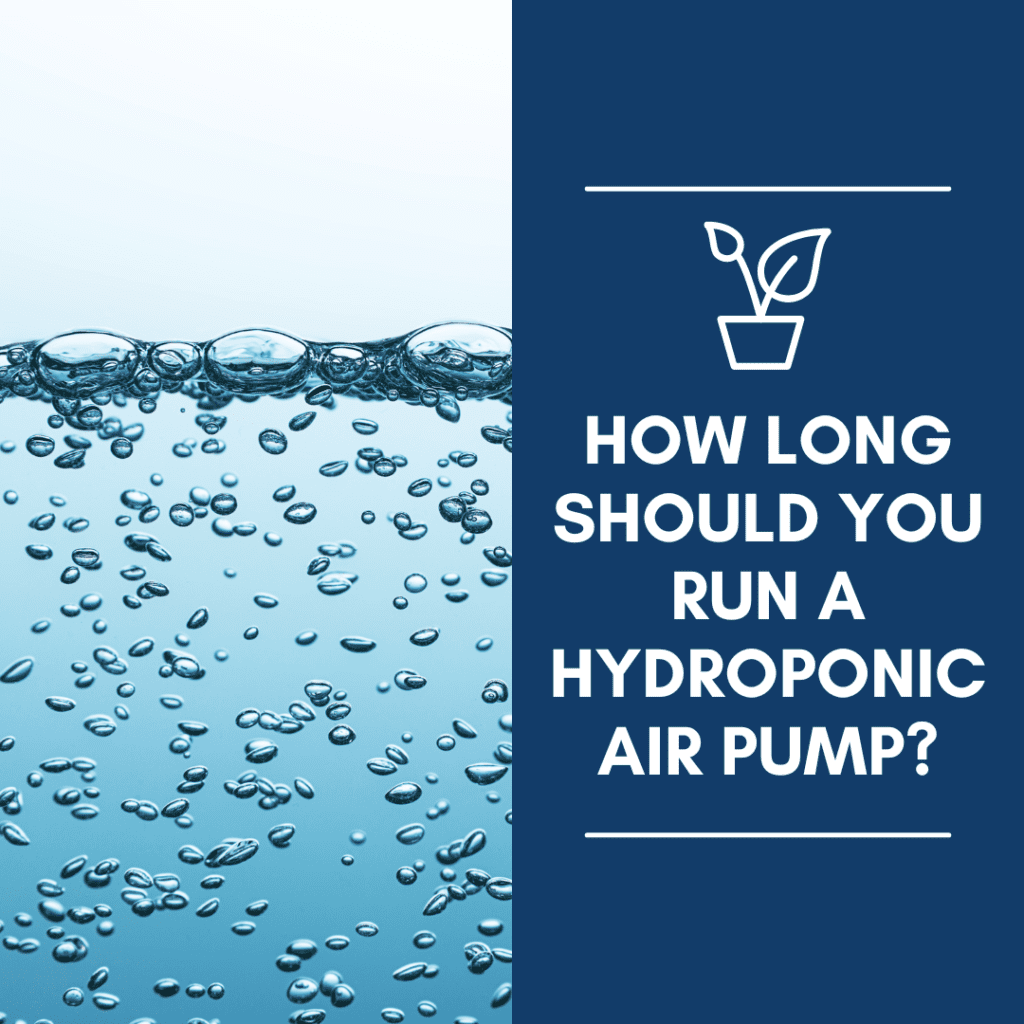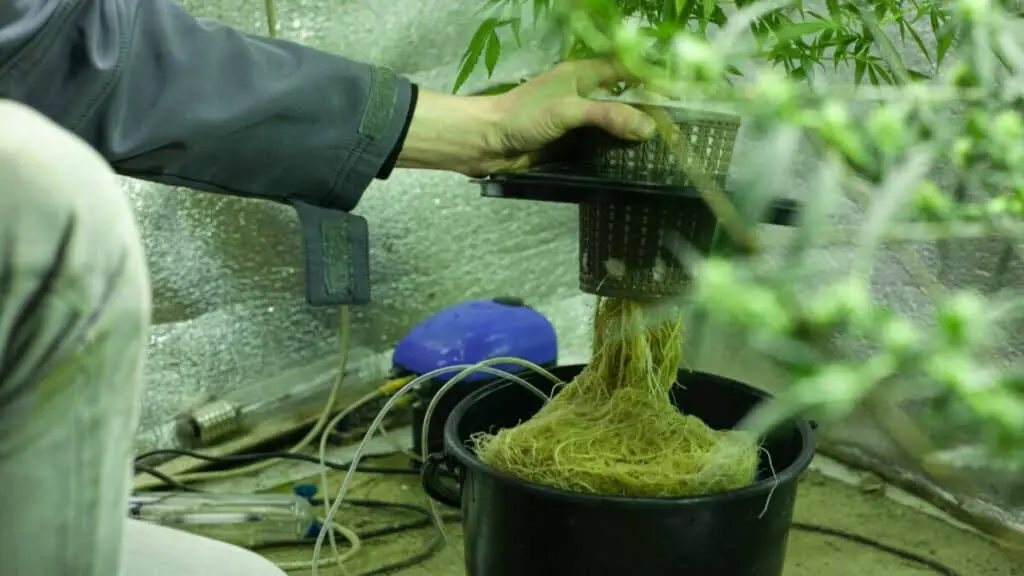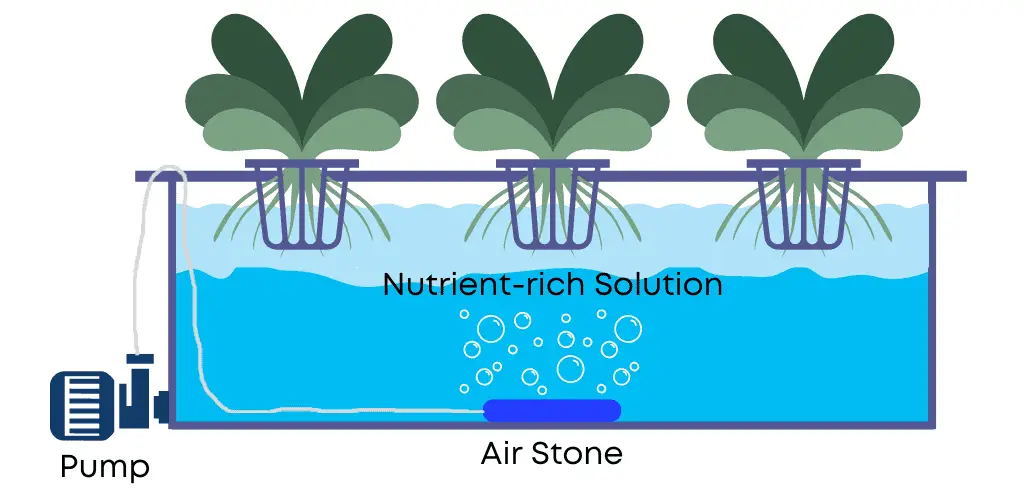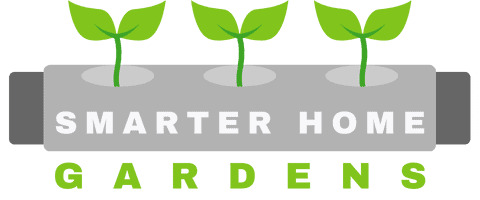This post contains affiliate links. As an Amazon Associate SmarterHomeGardens.com earns a small commission from qualifying purchases.

An aspect of hydroponics which people often overlook is the role oxygen plays in keeping your plants healthy and productive. One of the best ways of ensuring adequate levels of oxygen is to install an air pump in your hydroponics system. But how long you need to run the air pump to achieve optimal results can vary.
To ensure sufficient aeration of the nutrient solution, a hydroponic air pump should run for between 12 and 24 hours per day, depending on the size and type of hydroponics system and the oxygen requirement of the plants being grown. Any less than 12 hours is generally considered an insufficient amount of time to realise the benefits an air pump creates.
It took some tinkering, but now that I’ve understood precisely how to use my air pump for maximum effect I’ve started to notice positive changes in my plants. In this post, I’ll explain exactly how you should be running your hydroponic air pump, and how long for, as well as highlight which hydroponic systems should even have one in the first place.
Why do some hydroponics systems need an air pump?
The primary role of an air pump in hydroponics is to provide oxygen to the root systems of your plants. Pumping air into the reservoir helps to dissolve oxygen into the nutrient solution which plants can then more easily absorb through their roots.
But it isn’t all about oxygen. Air pumps help to prevent algae and other debris from building up in the reservoir. By regularly circulating the nutrient solution, an air pump can help to prevent areas of stagnant water that can lead to algae and other disease-causing detritus from building up.

Which hydroponic systems even require an air pump?
While many hydroponics systems would benefit from an air pump they are in fact, not strictly necessary in most cases. Air pumps are designed to aerate the nutrient solution and provide oxygen directly to any root systems immersed within it.
Therefore, an air pump is only a requirement for hydroponics systems which permanently submerge the root system.
Following this logic, there is just one type of hydroponics system where an air pump is sticky necessary: Deep Water Culture (DWC).
| Type of Hydroponics System | Is the Root System Submerged? | Is An Air Pump Required? |
|---|---|---|
| Deep Water Culture (DWC) | Yes | Yes |
| Aeroponics | No | No |
| Hydroponic Tower Gardens | No | No |
| Nutrient Film Tehcnique (NFT) | No | No |
| Ebb and Flow Hydroponics | No | No |
| Kratky Method | Yes (partially) | No |
| Wick Hydroponics | No | No |
However, while DWC is the only system where an air pump is really needed, adding one to other types of hydroponics systems can still have measurable benefits.
I’ve written an entire article about choosing the right size air pump for DWC hydroponics.
So, how long should you run a hydroponic air pump?
How long you run an air pump within a hydroponics system depends on the type of system you are using. Deep Water Culture (DWC) – which permanently submerges the root system – requires the air pump to run continually, whereas other types of systems do not.
Should you run the air pump 24/7?
The only hydroponics system that requires continuous aeration is Deep Water Culture (DWC). This is so that the root system (which is permanently submerged in the nutrient solution) receives enough oxygen.
| Type of Hydroponics System | Recommended daily air pump run time |
|---|---|
| Deep Water Culture (DWC) | 24 hours (continuous running) |
| Aeroponics | 12 hours (15 minutes on, 15 minutes off) |
| Hydroponic Tower Gardens | 12 hours (15 minutes on, 15 minutes off) |
| Nutrient Film Tehcnique (NFT) | 12 hours (15 minutes on, 15 minutes off) |
| Ebb and Flow Hydroponics | 12 hours (15 minutes on, 15 minutes off) |
| Kratky Method | N/A (no pump required) |
| Wick Hydroponics | N/A (no pump required) |
For other types of systems, an air pump is not strictly required. However, should you wish to install one, then running the air pump for 15 minutes in every 30 minutes for a maximum of 12 hours each day is generally considered sufficient.
Do you need a plug timer?
In Deep Water Culture, since you run the air pump 24/7, there is no need for a time timer to automate when the pump is switched on and off.
However, for the other types of hydroponics systems (listed above) you will need to purchase and use an automatic plug timer. Adding a plug timer will regulate and automate the flow of electricity to the pump. All you need to do is set the desired time(s) you wish your air pump to run for and let it do the rest.

BN-Link makes the most affordable and reliable mechanical plug timers you can buy quickly through Amazon.
How much does a hydroponic air pump cost to run?
How much your air pump costs to run depends on the size and power of the pump, how long you need to run it and the price of electricity. The good news is that for most systems the cost of running an air pump is relatively low.
On average, you can expect to pay around $0.01 and $0.05 per hour ($0.24-$1.2 per 24 hours) to run a small 3-watt hydroponic air pump like the Hydrofarm Active Aqua Air Pump. Larger pumps will cost more. But, the overall cost is still quite low.
What are the benefits of using an air pump in hydroponics?
Adding a hydroponic air pump to your system has a number of benefits that reach beyond simply aerating the nutrient solution and improving a plant’s oxygen intake. This is why some growers choose to add an air pump to systems other than DWC, even if it isn’t strictly required for the plant’s survival.
- Increased oxygen levels: An air pump helps to increase oxygen levels in the nutrient solution which is essential for the health and growth of your plants.
- Improved nutrient uptake: Increased oxygen within the nutrient solution can improve your plants’ ability to absorb nutrients leading to stronger and faster growth.
- Prevention of algae growth: Algae love low-oxygen environments. Keeping oxygen levels high with an air pump helps to prevent algae growth.
- Better root health: More oxygen in the nutrient solution can lead to improved root health which in turn creates stronger, healthier plants.
- Enhanced root rot: Root rot is a common problem in hydroponics, particularly in DWC. Higher oxygen levels can help to prevent this.
- Improved circulation: An air pump can help to circulate water and nutrients throughout the nutrient solution which helps to prevent a harmful build-up of algae, bacteria and fungi.

Do you need to use an air stone?
Most air pumps are typically used in conjunction with an air stone (sometimes referred to as a ‘bubbler’). An air stone is a lightweight stone (or brick veneer) that is placed into the nutrient solution and connected to the air pump via a hose.
When air passes through the stone it creates tiny bubbles that rise towards the surface and filter through the plant’s roots. These bubbles further help to oxygenate the water which benefits the plants.
What are the different types of pumps you can buy?
There are several different types of air pumps for hydroponics systems. The main two are;
- Diaphragm pumps: Probably the most popular type of pump, diaphragm pumps use an adjustable diaphragm to draw in and push out air with minimal noise. They’re great for smaller hydroponics systems and those running in locations where noise should be minimised.
- Piston pumps: Known for their superior power, piston pumps use pistons to compress air and then force it through the system. While they are more powerful, they are also much louder.
Ultimately, the type of air pump you choose will depend on your specific needs and budget. It’s important to consider the size of your hydroponics system, the type of plants you are growing, and the level of oxygenation you need when selecting an air pump.
Final thoughts
A hydroponic air pump is an excellent tool for increasing the amount of oxygen in the nutrient solution and preventing the reservoir from becoming stagnant. However, it’s only really necessary for a Deep Water Culture (DWC) hydroponics system which permanently submerges the plant’s roots. There are benefits for other types of hydroponics systems. But I haven’t personally seen the need to add a pump unless it’s absolutely necessary. Ultimately, it comes down to preference and what you are willing to spend and maintain.
